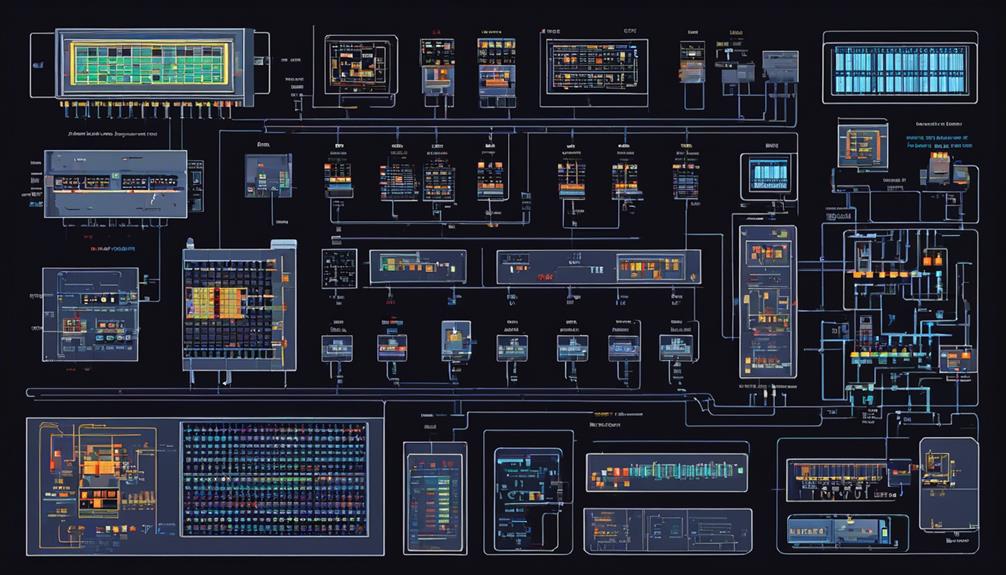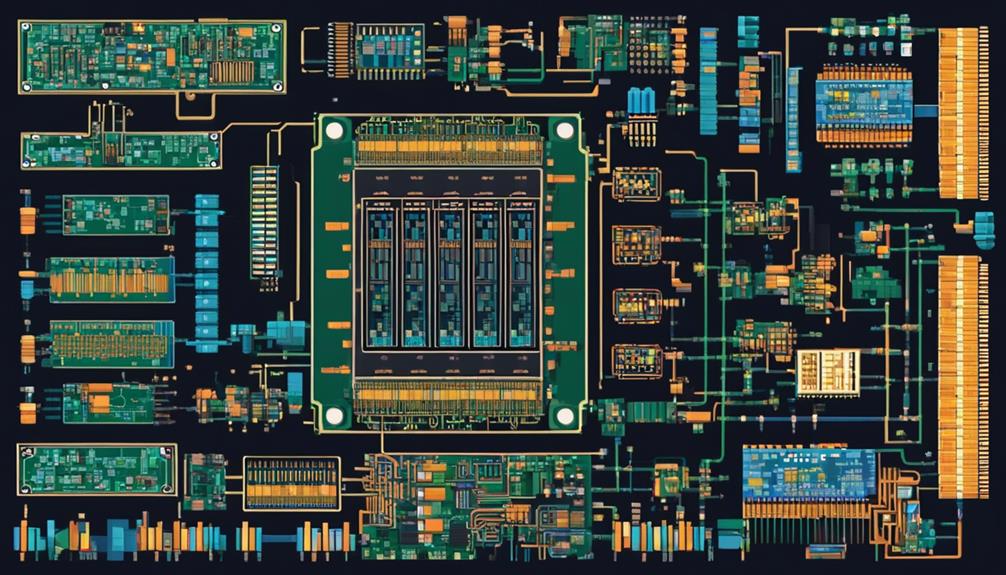In the rapidly evolving world of telecommunications, understanding RF amplifiers is essential for optimizing signal strength and ensuring reliable wireless communication. RF amplifiers play a crucial role in boosting signal levels, maintaining signal integrity, and driving low-impedance loads.
However, delving into the intricacies of these amplifiers can be quite complex. From the basic functions of gain, buffer, and driver amplifiers to the different types available, there is much to explore.
Additionally, the applications of RF amplifiers in various telecom systems, the key features and specifications to consider when choosing an amplifier, and the future trends and innovations in this field all contribute to the fascinating world of RF amplifiers.
So, let's embark on this journey together, unraveling the mysteries of RF amplifiers and discovering the crucial role they play in our modern communication networks.
Key Takeaways
- RF amplifiers play a crucial role in telecom systems by amplifying signals without introducing distortion or noise and maintaining signal shape and integrity.
- Different types of RF amplifiers, such as low-noise amplifiers, power amplifiers, and driver amplifiers, have specific functions and applications in telecom.
- When choosing an RF power amplifier, factors such as gain requirements, operating frequency range, power level, efficiency, and linearity should be considered.
- Frequency range is an important parameter to consider when selecting an RF amplifier, as it impacts the amplifier's performance and suitability for specific applications in telecom.
Basic Function of RF Amplifiers

RF amplifiers serve as essential components in telecommunications systems, fulfilling the crucial functions of amplifying signals, maintaining signal shape, and supplying sufficient current to drive loads. These amplifiers play a vital role in ensuring reliable and efficient communication by boosting the power of weak signals, compensating for signal losses, and enhancing the overall quality of the transmitted or received signals.
One of the primary functions of RF amplifiers is to amplify signals. They are designed to increase the power level of the input signal without introducing significant distortion or noise. This is particularly important in telecommunications systems where the strength of the received signals may be weak, such as in long-distance transmissions or when signals are transmitted through obstacles.
Another function of RF amplifiers is to maintain the shape and integrity of the signal. These amplifiers act as buffer stages, ensuring that the output signal matches the input signal in terms of frequency response, phase, and amplitude. By matching the output impedance to the input impedance, RF amplifiers maximize power transfer and minimize signal distortion.
Additionally, RF amplifiers serve as driver stages, providing sufficient current to drive low-impedance loads. In telecommunications systems, these amplifiers are often used to drive coaxial cables and antennas, which require a significant amount of power to transmit signals over long distances.
It is worth noting that some RF amplifiers combine multiple functions in a single device. This integration offers flexibility and efficiency in signal processing by reducing the number of components needed and simplifying the overall system design.
Different Types of RF Amplifiers
Amplifiers used in telecommunications systems are categorized into various types based on their specific characteristics and applications. Different types of RF amplifiers include low-noise amplifiers, power amplifiers, and driver amplifiers. Each type serves a distinct purpose in signal amplification and has unique features that make it suitable for specific applications.
Low-noise amplifiers (LNAs) are designed to amplify weak signals while introducing minimal additional noise. They are commonly used in receiver front-end circuits to improve the signal-to-noise ratio and enhance the system's sensitivity. LNAs typically operate in the frequency range of a few megahertz to several gigahertz.
Power amplifiers (PAs) are used to boost the power level of signals to drive antennas or other transmitting devices. PAs are essential components in wireless communication systems, enabling long-range transmission and coverage. They operate at high power levels and are designed to handle large output signals. The operating frequency range of power amplifiers depends on the specific application and can range from a few kilohertz to several gigahertz.
Driver amplifiers serve as an intermediate stage between low-power signal sources and power amplifiers. They provide additional gain and power to drive the subsequent power amplifier stage. Driver amplifiers are often used in RF transmitters and receivers to maintain signal integrity and ensure efficient signal transmission.
In addition to these basic types, there are other specialized RF amplifiers such as pulse amplifiers, CW amplifiers, traveling wave tube (TWT) amplifiers, solid-state RF amplifiers, and vacuum tube RF amplifiers. Each of these types serves specific purposes in different applications, offering unique advantages and trade-offs.
Understanding the different types of RF amplifiers is crucial for selecting the appropriate amplifier for a specific application. Factors such as gain requirements, operating frequency range, power level, and noise performance should be carefully considered when choosing an amplifier to ensure optimal performance and reliable signal amplification.
RF Amplifier Applications in Telecom

RF amplifier applications in telecom encompass various aspects, including power requirements, signal amplification, and frequency range.
Power requirements determine the amount of power needed to adequately amplify the signals in a telecom system.
Signal amplification is crucial to boost the strength of the signals to ensure their effective transmission and reception.
The frequency range refers to the range of frequencies that the RF amplifier can handle, which is vital for accommodating the different frequency bands used in telecom applications.
Power Requirements
Power requirements play a critical role in ensuring optimal performance and efficiency of RF amplifiers used in telecom applications. RF power amplifiers are vital for increasing the power level of RF signals before transmission. These amplifiers have specific requirements for gain, linearity, efficiency, and output power level to meet the demands of telecom systems. The design and operating parameters of RF power amplifiers are crucial factors in ensuring high-speed data transmission and satisfactory signal levels for receivers.
When choosing an RF power amplifier, considerations such as gain, operating frequency, output power level, efficiency, and linearity are essential. The output power of the RF amplifier is the final power amplification achieved, while the input signal power determines the required gain. It is crucial to balance output power level with efficiency to minimize power consumption and heat dissipation. Additionally, linearity is critical to avoid nonlinear distortions that can impact signal quality.
Signal Amplification
In the realm of telecom applications, the efficient and reliable performance of RF amplifiers relies heavily on their ability to perform signal amplification with precision and minimal distortion. RF amplifiers play a crucial role in amplifying the power of output signals, allowing for effective signal processing in various telecom applications. These amplifiers serve different functions, including gain amplifiers, buffer amplifiers, and driver amplifiers. Gain amplifiers boost signal levels while maintaining low noise and distortion, ensuring accurate signal processing. Buffer amplifiers maintain the shape and amplitude of a signal, minimizing distortion by matching output impedance to input impedance. Driver amplifiers are designed to source and sink sufficient current to drive low-impedance loads, withstanding short circuits and DC power rails. The table below summarizes the functions and purposes of each type of RF amplifier.
| RF Amplifier | Function | Purpose |
|---|---|---|
| Gain amplifier | Amplification | Boosts signal levels with minimal noise/distortion |
| Buffer amplifier | Amplification | Maintains signal shape and amplitude |
| Driver amplifier | Amplification | Sources/sinks current for low-impedance loads |
Frequency Range
The frequency range of an RF amplifier is a critical factor that determines its suitability for specific telecom applications. RF amplifiers are designed to operate within specific frequency ranges, allowing them to effectively amplify and process signals within those bands.
Different RF amplifiers are optimized for different frequency ranges, such as low frequency, microwave, or ultra-high frequency. The frequency range directly impacts the performance of an RF amplifier in amplifying and processing signals within a specific band.
For example, a power amplifier designed for low-frequency applications may not be suitable for amplifying high-frequency signals. Similarly, an RF amplifier optimized for microwave applications may not provide the desired performance for ultra-high frequency signals.
Understanding the frequency range of RF amplifiers is crucial for selecting the appropriate amplifier that can handle the desired frequency range while maintaining low noise and providing sufficient RF power for the specific telecom application.
Key Features and Specifications of RF Amplifiers

RF amplifiers are essential components in telecommunications systems, offering a wide range of features and specifications to enhance signal strength and quality. Here are three key features and specifications of RF amplifiers:
- Gain: RF amplifiers can have fixed-gain values or variable gain within a wide range. Gain refers to the amplification factor of an amplifier and determines the increase in signal power. Higher gain amplifiers can boost weak input signals to a desired output level, improving overall signal quality.
- Function Integration: Some RF amplifiers combine more than one function in a single device, such as gain, buffer, and driver functions. Buffer amplifiers match the impedance of the output to the impedance of the input, maximizing power transfer and minimizing distortion. Driver amplifiers are designed to source and sink sufficient current to drive low-impedance loads, such as coaxial cables and antennas. Integration of these functions simplifies system design and reduces component count.
- Load Compatibility: Critical specifications for buffers include the range of resistive and reactive loads they can drive. RF amplifiers should be able to operate with a wide range of output signals and drive different types of loads effectively. This ensures compatibility with various telecommunications systems and allows for flexibility in signal routing and distribution.
Additionally, other important specifications of RF amplifiers include low noise performance, which is crucial for maintaining signal integrity, and power level capabilities, which determine the maximum power output the amplifier can handle.
Considerations for Choosing RF Amplifiers
When selecting RF amplifiers, it is crucial to carefully consider various factors and specifications to ensure optimal performance for specific applications. The following table provides an overview of the key considerations for choosing RF amplifiers:
| Consideration | Description | Importance |
|---|---|---|
| Gain | The ratio of output power to input power, it is a vital parameter that determines amplification. | High gain amplifiers are preferred for applications that require significant amplification |
| Operating Frequency | The frequency range within which the amplifier operates. | The amplifier's frequency range must align with the application's requirements for effective operation |
| Linearity | The ability of the amplifier to accurately reproduce the input signal. | Linear amplifiers are preferred for applications that require faithful reproduction of input signals |
| Efficiency | The ratio of output power to input power, it determines how effectively the amplifier converts power. | High-efficiency amplifiers minimize power losses and maximize output power |
| Output Power Level | The maximum power that the amplifier can deliver. | The amplifier's output power level should meet the requirements of the application |
| Low Noise | The level of unwanted noise introduced by the amplifier. | Low-noise amplifiers are preferred for applications that require minimal noise interference |
| Designed RF Signal | The type of RF signal the amplifier is designed to handle. | The amplifier should be able to handle the specific RF signal characteristics of the application |
Amplifier Gain and Performance

Amplifier gain plays a vital role in achieving optimal performance in RF amplifiers. It is essential to consider the tradeoff between gain and noise, as increasing gain can introduce additional noise into the system.
Linearity and distortion are also crucial factors to consider, as they can impact the signal quality and integrity.
Moreover, efficiency and power are important considerations for ensuring the amplifier operates efficiently and reliably.
Gain Vs. Noise
The performance of an RF amplifier is determined by its gain and the level of noise introduced into the signal. When considering RF amplifiers, it is essential to understand the trade-off between gain and noise performance. Here are three key points to consider:
- Amplifier Gain:
The gain of an RF amplifier determines how much it can amplify the input signal. Higher gain values are desirable when the RF signal amplitude is too low for use in the circuit. Amplifiers with fixed-gain values or variable gain within a wide range can accommodate various signal amplitudes.
- Noise:
Noise refers to any unwanted signals or disturbances that can degrade the quality of the output signals. Low-noise amplifiers (LNAs) are used to boost extremely low-level signals while minimizing additional noise. LNAs are crucial in applications where signal sensitivity is paramount.
- Noise Performance:
When evaluating RF amplifiers, it is important to consider their noise performance. This includes parameters such as noise figure, which quantifies how much noise the amplifier adds to the input signal. Lower noise figures indicate better noise performance.
Linearity and Distortion
Linearity and distortion are critical aspects to consider when evaluating the gain and performance of RF amplifiers. Linearity ensures that the output signals faithfully reproduce the input RF signals without any distortion.
Distortion in RF amplifiers can arise from nonlinear behavior, leading to signal degradation and the generation of unwanted spurious emissions. The linearity of an amplifier determines its ability to accurately amplify RF signals without introducing any distortion.
Understanding the distortion characteristics of an amplifier is crucial in maintaining signal integrity and fidelity. Linearity and distortion are key factors in determining the overall performance of RF amplifiers, as they directly impact the amplifier's ability to faithfully amplify RF signals while preserving their quality and minimizing any undesirable effects.
Efficiency and Power
When evaluating the gain and performance of RF amplifiers, another critical aspect to consider is the efficiency and power, which directly impact the amplifier's ability to convert DC power into RF power effectively.
Here are three important points to understand about power efficiency and its significance in RF amplifiers:
- Efficiency Measurement: Efficiency is a measure of how effectively an RF amplifier converts DC power into RF power. It is calculated by dividing the RF power output by the DC power input and expressing it as a percentage. Higher efficiency means more of the DC power is converted into RF power, reducing power consumption and heat dissipation.
- Power Gain: Power gain is the ratio of the output power to the input power and is a key performance metric for RF amplifiers. It indicates how much the input power is amplified to produce the desired output power. Higher power gain implies better amplification of RF signals.
- Importance of Efficiency: Amplifier efficiency is crucial for minimizing power consumption and maximizing battery life in wireless devices. By ensuring efficient conversion of power, RF amplifiers can contribute to improved overall system performance and reduced energy consumption.
Understanding the relationship between power, efficiency, and performance is essential for optimizing the design and operation of RF amplifiers in various applications. By focusing on power efficiency, engineers can enhance the effectiveness and reliability of RF amplifiers in delivering high-quality amplified signals.
RF Amplifier Power Efficiency

RF amplifier power efficiency is a critical factor in determining the effectiveness of converting DC power into RF power. It refers to how efficiently the amplifier converts the input DC power into the desired RF power output. Power efficiency is calculated as the ratio of RF power output to DC power input and is typically expressed as a percentage.
High power efficiency is desirable as it means less wasted power and reduced heat generation. Efficient RF amplifiers are crucial in reducing power consumption and improving overall system performance.
When considering power efficiency, it is important to note that different RF amplifiers have varying efficiency levels. Some amplifiers have a wide power efficiency range, while others may have lower efficiency levels.
The power efficiency of RF amplifiers is particularly important in applications where power consumption is a concern, such as in mobile communication systems. Efficient amplifiers help minimize power usage and prolong battery life in portable devices.
In addition to power efficiency, it is also important to consider the output signal quality of RF amplifiers. While high power efficiency is desirable, it should not come at the expense of signal distortion or degradation. RF amplifiers should be selected based on a balance between power efficiency and signal quality to ensure optimal performance.
Future Trends and Innovations in RF Amplifiers
Advancements in wireless communication technology are driving the development of future trends and innovations in RF amplifiers, with a focus on improving efficiency and linearity. As the demand for faster and more reliable wireless communication continues to grow, RF amplifiers play a crucial role in ensuring stable and high-speed data transmission.
Here are three key areas of innovation in RF amplifiers that are shaping the future of wireless communication:
- Improved Efficiency: Future trends in RF amplifiers aim to achieve higher levels of efficiency in power consumption. This is essential for reducing energy consumption and extending battery life in wireless devices. Researchers are exploring various techniques such as envelope tracking and digital predistortion to optimize power efficiency in RF amplifiers.
- Enhanced Linearity: Linearity is a critical factor in maintaining signal quality and avoiding interference in wireless communication systems. Future RF amplifiers are being designed to minimize distortions and improve linearity, especially in high-power amplification scenarios. This is particularly important in applications such as satellite communication, where multiple signals need to be transmitted simultaneously without mutual interference.
- Wide Operating Frequency Range: With the increasing demand for multi-band and multi-mode wireless communication systems, future RF amplifiers are being developed to operate over a wide frequency range. This enables seamless connectivity across different wireless standards and bands, providing greater flexibility and compatibility in modern communication networks.
These ongoing innovations in RF amplifiers are driven by the need to address the non-linear characteristics that affect efficiency, linearity, and signal quality in amplification systems. By continuously improving power efficiency, linearity, and operating frequency range, RF amplifiers will play a pivotal role in meeting the evolving requirements of wireless communication systems in the future.
Frequently Asked Questions
What Are the Basics of RF Amplifier?
RF amplifiers are electronic devices used to amplify RF signals. They come in various types, including gain, buffer, and driver amplifiers, each serving different functions in amplifying, maintaining signal shape, and driving loads.
RF amplifiers find applications in various industries, including telecommunications. When designing RF amplifiers, considerations such as frequency range, power output, and linearity must be taken into account. Specifications such as gain, noise figure, and input/output impedance are important for evaluating performance.
RF amplifier circuitry typically includes components such as transistors, capacitors, and inductors.
What Is the Function of RF Amplifier in Communication System?
The function of an RF amplifier in a communication system is to amplify RF signals while maintaining signal integrity and minimizing noise and distortion. RF amplifiers are crucial for boosting low-level RF signals from antennas to levels suitable for further signal processing. They also ensure proper impedance matching and current sourcing/sinking capabilities for driving low-impedance loads.
Design considerations for RF amplifiers include gain, frequency response, noise figure, power handling capabilities, and distortion and linearity characteristics. These factors are important for ensuring optimal performance and reliability in communication systems.
What Are the Two Classes of RF Amplifiers?
The two classes of RF amplifiers are Class A and Class B.
Class A amplifiers operate with a bias that allows the active device to conduct through the entire RF cycle, offering higher linearity and lower distortion.
On the other hand, Class B amplifiers function with an active device biased to conduct for only half of the RF cycle, providing higher power efficiency but with higher distortion and lower linearity.
These classes need to be considered when addressing power requirements, efficiency considerations, noise performance, gain control, distortion effects, and thermal management.
What Is Amplifier in Telecommunication?
Amplifiers play a crucial role in telecommunication systems by boosting the strength of signals to ensure efficient transmission and reception. There are various types of amplifiers used in the telecom industry, including power amplifiers, distribution amplifiers, and preamplifiers.
Design considerations in telecommunication applications include frequency response, linearity, and noise figure. Amplifier efficiency and power output are crucial factors in telecom systems to maximize performance.
Common challenges in RF amplifier design for telecommunication include thermal management and achieving high linearity.
Future advancements in RF amplifier technology for telecom involve improving efficiency, reducing size, and enabling higher data rates.

